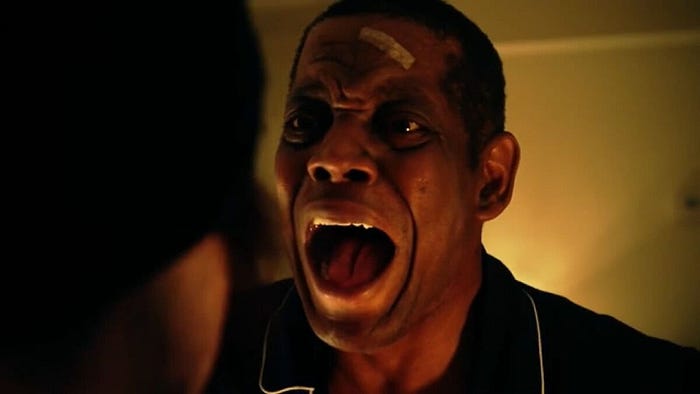The Ari Aster Movies Ranked

Ari Aster seemed to come out of the gate with a huge horror success with HEREDITARY, sparking conversations about the place of “elevated horror” (I hate that term) in a film industry ever more reliant on blockbuster action and the mainstreaming of “indie” production through labels like A24. But Aster had steadily built a body of short subject work for a decade prior to HEREDITARY’s release. Indeed, Aster has made 11 total films in the 15 years since 2008, although three features have come in just the last five years. Known for his immensely popular and somewhat trendy artful horror, taken as a whole, Aster has actually made a bigger part of his work about sophomoric humor and offbeat tone away from the genre conventions with which he is credited for making “arty.”
#11 — TDF REALLY WORKS (2011)

Clocking in at just about two minutes, TDF REALLY WORKS is less a “short film” and more a YouTube-esque commercial parody sketch about “dick farts” and a product that can create them. It’s pretty adolescent stuff, which I am certainly not always against, but it’s pulled off with a forced comedic timing, and an admittedly stomach-churning series of diagrams, that it never sticks the landing for its outrageous premise. TDF REALLY WORKS is without a doubt the low-point of Aster’s directorial career, but considering its scope, it’s not like that’s a tremendous disappointment.
#10 — C’EST LA VIE (2016)

Returning to a similar visual style and fourth-wall-breaking premise he had utilized for a short a few years earlier, C’EST LA VIE is a commentary on homelessness and the American dream. The short, Aster’s last before turning to feature filmmaking, is just not a particularly well-made argument. I understand its heavy-handed and extremist moments are intended as a shock to the system of complacence, but the whole experience ends up feeling like the “artsy short film” equivalent to that one dude talking too much in a college philosophy class. C’EST LA VIE isn’t wrong in its intentions, but it’s not a particularly compelling watch.
#9 — THE TURTLE’S HEAD (2014)

Continuing the through line of dick jokes in Aster’s career, THE TURTLE’S HEAD starts as a parody of misogynistic noir before dovetailing into a kind of penile body horror experience, albeit one with a sense of comedic timing that is borrowed from the sorry experience of TDF REALLY WORKS. Richard Riehle is actually pretty good as the slimy detective, but once again, the criticism or message of the short is undermined by a lack of subtlety that grates more than it impresses. Indeed, I sometimes think subtlety is overrated, but THE TURTLE’S HEAD isn’t an example of good didacticism.
#8 — BASICALLY (2014)

Marginally better in the vein of didacticism is BASICALLY, starring Rachel Brosnahan, who I love. This critique of LA-based hypocrisy and egotism is itself often cringey to behold, as Brosnahan takes us on a tour of her life and surroundings in a fourth-wall-breaking, monologuing style that Aster would revive for C’EST LA VIE. His visual approach, in framing Brosnahan against big wide shots, cleverly arranged with bystanders and intriguing set dressing, is pretty interesting, but after a while, I wished I could see the actor more clearly. BASICALLY is the best of Aster’s middling-to-bad shorts, but it has the same head-pounding approach of imparting its message as those other works.
#7 — MUNCHAUSEN (2013)

Aster’s “silent” work wordlessly takes us through the imagination, then the horrible betrayal, of a mother whose son is going off to college. The almost whimsical visual style, reminding me of a colorful Tim Burton set design approach in one instance, and a correspondingly fantastical score ironically pair well with the desperate act at the center of MUNCHAUSEN.
#6 — BEAU (2011)

Expanded both in concept and in the execution of one scene in particular for Aster’s feature BEAU IS AFRAID, BEAU is a surreal exploration of a paranoid, mommy-fearing man, like that later work. Its pivoting from one extreme reaction to the next is sufficiently unsettling, even as it generally strikes a darkly humorous tone. BEAU is more limited in production value and stylistic approach than later shorts, but its central strangeness is certainly better felt.
#5 — THE STRANGE THING ABOUT THE JOHNSONS (2011)

Seemingly resurfaced at a wide scale after the success of HEREDITARY and MIDSOMMAR, THE STRANGE THING ABOUT THE JOHNSONS is indeed a fucked up experience, as it came to be described. The longest of Aster’s shorts at 29 minutes and his most ambitious film before HEREDITARY, THE STRANGE THING ABOUT THE JOHNSONS is one of two explicit works in the horror genre up to that time. Not only is the film’s subject matter a taboo and frightening one, but the images Aster deploys calls to mind shots from films like THE SHINING (1980). This is a truly unsettling movie that also feels strangely empty by the time the credits roll. But not being sure about how I feel about THE STRANGE THING ABOUT THE JOHNSONS, which portrays terrible things with effective filmic language, is perhaps the point.
#4 — HERMAN’S CURE-ALL TONIC (2008)

Aster’s first short, while more amateurish in some respects than those to come, is also an impressive cultivation of offbeat tone. Operating in a space not unlike the one occupied by COURAGE THE COWARDLY DOG (1999–2002) or THE GREASY STRANGLER (2016), high compliments indeed in my book, HERMAN’S CURE-ALL TONIC tactically deploys gross-out effects amid delightfully awkward interactions between a pharmacist, his father, and a customer. Serving a goofier kind of horror than that of THE STRANGE THING ABOUT THE JOHNSONS or Aster’s features, the short nevertheless stands as the director’s best. HERMAN’S CURE-ALL TONIC has a charmingly unsettling aesthetic that sets it apart from, for some examples, the didactic politics of C’EST LA VIE, the sophomoric humor of TDF REALLY WORKS, or the truly unsettling experience of THE STRANGE THING ABOUT THE JOHNSONS.
#3 — BEAU IS AFRAID (2023)

Aster’s latest film at the time of this writing came at the end of the biggest gap between releases for the director at just shy of four years. The time was obviously spent to create a mammoth movie, one just under three hours long and packed full of heavy-handed parallels yet also frustratingly obtuse allegory. Having just watched all of Aster’s shorts, HEREDITARY and MIDSOMMAR have emerged as the deviations within his filmography, rather than the other way around concerning BEAU IS AFRAID. This movie contains at least one concept from each of his pre-HEREDITARY films, from exquisitely arranged wide shots to paranoid sons and overbearing mothers to commentary on societal collapse to, yes, penises. Much has been made about the prevelance of mommy issues, baths, attics, and more in Aster’s work, and the confluence of so many previous preoccupations almost threatens to overwhelm BEAU IS AFRAID with so much psychological baggage. But that unloading of so many painful moments and bizarro images, stitched together in a surreal structure that is a wonder in today’s mainstream film conversation, is ultimately quite impressive. Because there are starkly diverging scenarios within BEAU IS AFRAID, my enjoyment of its twisted odyssey varied, but I know that the film will stick with me.
#2 — MIDSOMMAR (2019)

Looking back on BEAU IS AFRAID’s feature predecessors makes them look almost conventional by comparison. But the fact remains that Aster’s two prior films are incredible works of modern horror, in spite of the noxious elevated horror label affixed to them and an idea that they stand in contention with artful horror of the past. MIDSOMMAR, while very clearly echoing movies like THE WICKER MAN (1973) and other pagan/folk horror movies, is effective in committing unease and terror to memory in the face of broad daylight. The ratcheting pace of the film offers a slow burn experience that flames into a remarkable climax that has resulted in fiercely debated interpretations about the behavior of the central characters. MIDSOMMAR makes its point about cults and charisma very clearly, but surrounding elements also communicate their own, subtler messages. In service of these themes, Aster employs a dizzying array of fantastical images and creative framing, surrounding great performances. MIDSOMMAR is a great horror movie, albeit one that made me think more than it made me outright scared.
#1 — HEREDITARY (2018)

But Aster’s debut feature succeeded on both counts. HEREDITARY is a film that slowly but surely enfolds its tentacles of horror. Refined in a way unlike any of his preceding shorts, the movie is one of those that profoundly scared me. Certain images stand out to me as seminal ones in the whole scope of the horror genre. And still others, while not outright nerve-shattering, are creepy moments of anticipation and unease. HEREDITARY’s exploration of paranormal concepts is neither overexplained nor frustratingly vague, operating in a tantalizing ambiguity that only serves to deepen the terror. Toni Collette’s performance is outstanding, but the whole cast shows up for a series of traumatizing events, for the characters themselves as well as the audience. The film’s visual style, its darkness the antithesis of MIDSOMMAR’s brightness, is able to communicate legible movement, but just barely in service of the fear of what lies just out of sight. HEREDITARY is a spectacular film, one that gives me chills and wonder at the craft of it, and stands as Aster’s best.
